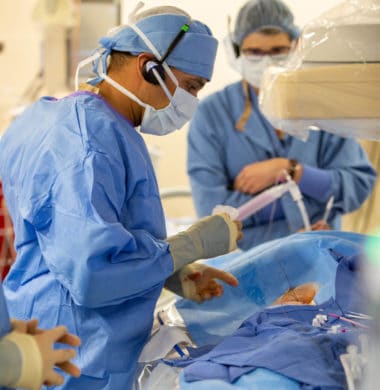Avoid heart disease with Cardiology care: A preventive strategy
Avoid heart disease with Cardiology care: A preventive strategy
Blog Article
Comprehending the Value of Cardiology in Modern Health Care Solutions
Cardiology plays an essential function in modern-day healthcare, particularly as cardiovascular disease remains to be the leading reason for mortality worldwide. Developments in diagnostics and therapy have transformed person care, allowing earlier interventions and enhanced outcomes. In addition, the shift in the direction of precautionary cardiology encourages people to manage their health and wellness proactively. As innovation remains to evolve, the integration of cutting-edge remedies might additionally redefine cardiology's influence on public health and wellness, triggering a closer examination of arising fads and their implications.
The Frequency of Cardiovascular Disease and Its Influence On Public Health
Although heart disease continues to be the leading reason of death internationally, its effect extends much beyond specific clients to affect public wellness systems and economies. The high frequency of cardiovascular disease positions a considerable strain on health care resources, requiring increased financing for treatment, avoidance, and rehabilitation programs. Public wellness initiatives have to deal with danger variables such as weight problems, smoking cigarettes, and sedentary way of lives, which add significantly to the increasing occurrence of heart conditions.Moreover, the economic concern related to heart disease is immense, including not just direct medical expenses yet additionally indirect expenses associated with lost efficiency and premature mortality. Neighborhoods encounter obstacles in managing these prices, typically bring about disparities in healthcare gain access to and results. As the populace ages and lifestyle-related dangers remain to intensify, the seriousness for efficient cardiology treatments comes to be extremely important. Consequently, addressing heart problem is not only a matter of individual health but also a vital public health and wellness concern.
Developments in Heart Diagnostics and Imaging Techniques
Recent developments in cardiac diagnostics and imaging strategies have actually reinvented the area of cardiology, enhancing the ability to spot and keep track of heart conditions. Methods such as cardiac MRI, CT angiography, and echocardiography have actually ended up being progressively sophisticated, providing comprehensive pictures of heart frameworks and functions. These methods enable the early identification of conditions like coronary artery condition, cardiac arrest, and valvular disorders.Moreover, improvements in non-invasive diagnostics, such as wearable innovation and remote monitoring tools, have encouraged patients and doctor. These tools facilitate real-time monitoring of heart rhythms and other necessary indications, causing timely treatments. Additionally, expert system is being incorporated into imaging evaluation, enhancing accuracy and effectiveness in diagnosis.
Advancements in Treatment Choices for Heart Issues
Recent innovations in cardiology have actually resulted in substantial innovations in therapy alternatives for heart disease. These consist of advanced medical methods that boost procedural results and arising medications that provide brand-new opportunities for treatment. As the field develops, these technologies play a vital function in boosting person care and outcomes.
Advanced Surgical Techniques
Developments in medical techniques have actually changed the landscape of cardiology, offering new hope for individuals with heart disease. Minimally invasive procedures, such as catheter-based interventions, have considerably lowered recovery times and healthcare facility keeps. Techniques like robotic-assisted surgery enhance precision, enabling specialists to navigate complex physiological frameworks with greater accuracy. Moreover, innovations in imaging innovation facilitate real-time visualization during procedures, improving outcomes. Transcatheter aortic shutoff substitute (TAVR) exemplifies a development in treating aortic stenosis, enabling shutoff substitute without open-heart surgical procedure. In addition, hybrid techniques that integrate surgical and catheter-based approaches give customized services for various cardiac concerns. These sophisticated surgical techniques not just improve client safety but likewise broaden treatment alternatives, highlighting the vital role of innovation in modern-day cardiology methods.
Emerging Drugs and Therapies
As the landscape of cardiology continues to advance, emerging medications and treatments play an essential role in boosting treatment alternatives for heart disease. Innovations such as unique anticoagulants and advanced lipid-lowering representatives have changed the management of heart diseases, substantially decreasing patient morbidity and mortality. In addition, the advancement of genetics therapies and regenerative medication offers encouraging avenues for dealing with problems previously regarded irreparable. Scientific trials are continuously disclosing the effectiveness of these treatments, pressing the boundaries of standard treatments. Furthermore, the assimilation of digital health and wellness modern technologies helps with individualized medication, allowing for tailored therapy strategies based on genetic and way of life variables. Jointly, these innovations underscore the dynamic nature of cardiology, improving client results and redefining criteria of treatment in modern-day medical care.
The Role of Preventive Cardiology in Patient Treatment
Precautionary cardiology plays an essential role in client treatment by concentrating on the recognition of threat variables that add to heart problem. Through lifestyle modification strategies and early discovery strategies, doctor can effectively reduce the incidence of cardio occasions - Dr Garcia. This aggressive strategy not just enhances individual results but also advertises lasting health and wellness
Danger Element Identification
While cardio conditions remain a leading reason of morbidity and death worldwide, efficient threat aspect identification serves as a keystone of precautionary cardiology. Determining risk variables such as high blood pressure, diabetic issues, hyperlipidemia, and family members background is important for very early intervention. Healthcare experts utilize numerous screening approaches to assess these variables, enabling for tailored safety nets. Furthermore, understanding an individual's lifestyle selections, such as smoking and physical lack of exercise, further notifies threat evaluations. This thorough examination makes it possible for clinicians to create personalized treatment strategies targeted at mitigating dangers. By focusing on risk aspect recognition, healthcare systems can improve person outcomes and decrease the total burden of cardiovascular illness, inevitably adding to enhanced public health and wellness approaches and resource allotment.
Way Of Living Alteration Strategies
A wide variety of researches highlights the critical role of way of life adjustment approaches in reducing cardiovascular disease danger. These methods incorporate nutritional adjustments, raised exercise, smoking cessation, and weight management. By embracing a heart-healthy diet plan rich in fruits, vegetables, entire grains, and lean healthy proteins, people can decrease cholesterol degrees and blood stress. Normal exercise reinforces the heart and boosts total cardio wellness. In addition, giving up smoking cigarettes substantially lowers the threat of cardiovascular disease and boosts recuperation prices for those with current conditions. Weight management further adds to cardio wellness by alleviating other risk factors such as diabetes mellitus and high blood pressure. Carrying out these way of life alters not only advertises private wellness but additionally offers as a keystone of precautionary cardiology in client care.
Early Detection Strategies
Way of life adjustments greatly add to minimizing cardiovascular condition dangers, but they are most reliable when coupled with early discovery methods. Preventive cardiology highlights the importance of recognizing prospective heart issues prior to they escalate right into major problems. Techniques such as blood stress tracking, read what he said cholesterol testing, and advanced imaging modern technologies like echocardiograms play vital roles in reviewing cardiovascular wellness. Biomarkers and genetic screening also improve the accuracy of early discovery, enabling tailored preventative techniques. Normal cardiac danger evaluations equip doctor to interfere proactively, potentially stopping cardiac arrest and strokes (Cardiology). By integrating these early discovery approaches into routine treatment, people can gain from timely way of life treatments and targeted therapies, ultimately enhancing end results and boosting lifestyle
Integrating Technology Into Cardiology Practices
As developments in innovation proceed to improve numerous fields, the integration of ingenious tools and systems right into cardiology methods has actually come to be essential for enhancing client care and results. Telemedicine platforms allow cardiologists to monitor patients remotely, improving access to care while decreasing the problem on medical care centers. Wearable tools, such as smartwatches, make it possible for continual heart price surveillance, signaling both medical professionals and people to possible concerns in real-time. In addition, expert system (AI) is being used to evaluate large amounts of heart information, helping in early diagnosis and personalized therapy strategies. Advanced imaging methods, including 3D echocardiography, enhance visualization of heart frameworks, bring about a lot more exact interventions. Digital wellness records (EHRs) improve patient details administration, ensuring that cardiologists have immediate accessibility to critical information. Together, these technical improvements are transforming cardiology, advertising positive management and boosted health and wellness outcomes for people with cardiovascular conditions.
The Importance of Individual Education and Interaction
Patient education and involvement play a critical duty in the management of cardio wellness. By gearing up people with knowledge regarding their problems, treatment choices, and way of living adjustments, health care providers equip people to take an energetic role in their care. This positive strategy can lead to enhanced adherence to recommended drugs, nutritional changes, and exercise programs, inevitably reducing the risk of complications.Engagement likewise promotes a solid patient-provider partnership, urging open communication and count on. When clients really feel educated and entailed, they are most likely to voice concerns and ask questions, which can result in much better scientific results. In addition, instructional sources, such as workshops or electronic systems, can boost understanding and advertise self-management methods. On the whole, focusing on person education and learning and involvement is crucial for boosting cardio wellness, enhancing lifestyle, and minimizing health care expenses connected with cardiovascular diseases.
Future Fads in Cardiology and Their Possible Influence

Regularly Asked Concerns
What Lifestyle Changes Can Lower Cardiovascular Disease Risk?
The current inquiry addresses way of life changes that can substantially minimize cardiovascular disease risk. Cardiologist near me. Taking on a balanced diet regimen, participating in regular exercise, preserving a healthy and balanced weight, handling tension, and staying clear of tobacco can find especially enhance cardiovascular health and wellness
How Can I Identify Early Indicators of Heart Problems?
Identifying early indicators of heart problems includes monitoring signs such as chest discomfort, lack of breath, tiredness, and uneven heartbeat. Prompt recognition of these signs can motivate required clinical evaluation and intervention for far better outcomes.
What Are the Distinctions In Between Cardiologists and Cardiac Surgeons?
The differences in between cardiologists and cardiac specialists depend on their roles; cardiologists mostly handle and detect heart conditions with non-invasive approaches, while heart surgeons do procedures to correct structural heart problems. Each plays an essential, distinct function.

Exactly how Typically Should I Get My Heart Health Checked?
The regularity of heart medical examination varies based upon private risk factors. Usually, grownups should go through evaluations each to 2 years, while those with current conditions might need more constant evaluations as advised by medical care experts.
What Role Does Genes Play in Cardiovascular Disease Threat?
Genetics greatly influences heart disease danger, with familial patterns suggesting inherited conditions. Specific genes can incline individuals to high blood pressure, cholesterol issues, and various other cardiovascular issues, highlighting the index importance of genetic testing in assessing heart wellness. Heart disease continues to be the leading cause of death globally, its effect expands far beyond specific patients to impact public wellness systems and economies. Public wellness initiatives should resolve risk aspects such as obesity, smoking cigarettes, and sedentary way of lives, which add substantially to the increasing incidence of heart conditions.Moreover, the financial burden connected with heart illness is tremendous, encompassing not only direct clinical prices yet also indirect expenses associated to lost efficiency and early death. Preventative cardiology plays an important function in individual treatment by concentrating on the recognition of threat factors that contribute to heart disease. Synthetic intelligence (AI) and device discovering are improving diagnostics and individual surveillance, making it possible for very early discovery of heart conditions. The distinctions in between cardiologists and heart specialists exist in their functions; cardiologists mostly detect and take care of heart conditions through non-invasive methods, while cardiac surgeons perform medical treatments to remedy architectural heart problems.
Report this page